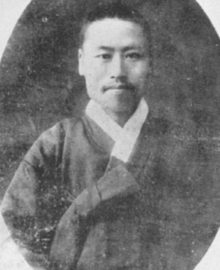Ju Si-gyeong
Ju Si-gyeong (December 22, 1876 – July 27, 1914) was one of the founders of modern Korean linguistics. He was born in Bongsan-gun, Hwanghae Province. He and his students helped standardize the Korean language, based spelling and grammar of the vernacular.
| Ju Si-gyeong | |
 Portrait of Ju Si-gyeong | |
| Korean name | |
|---|---|
| Hangul | |
| Hanja | |
| Revised Romanization | Ju Sigyeong |
| McCune–Reischauer | Chu Sigyŏng |
| Pen name | |
| Hangul | |
| Revised Romanization | Hanhinsaem, Hanhuinme |
| McCune–Reischauer | Hanhinsaem, Hanhŭinme |
| Courtesy name | |
| Hangul | |
| Hanja | |
| Revised Romanization | Sangho |
| McCune–Reischauer | Sangho |
Biography
Ju Si-gyeong was born in Hwanghae-do, now North Korea. He studied Classical Chinese from his childhood. Ju moved to Seoul in 1887.[1] He was interested in the Western learning methods and he studied Linguistics in one of these new schools.
After studying modern linguistics in Seoul, he found work in the first Hangeul-only newspaper Dongnip Sinmun in 1896,[1] founded by the independence activist Soh Jaipil. In 1897, Seo was sent into the exile to the United States and Ju left the newspaper.
He served as a Korean instructor for the American missionary W.B. Scranton, founder of today's Ewha Womans University.[1]
Standardizing Korean Language
In 1886, Ju realized the need of a standardized alphabet.[1] With some colleagues, he established the Korean Language System Society (Korean: 조선문동식회; Hanja: 朝鮮文同式會).[1] He hosted several seminars in the National Language Discussion Centre of the Sangdong Youth Academy of the Korean language (Korean: 상동청년학원국어강습소; Hanja: 尚洞青年學院國語講習所).
He proposed that the Korean parts of speech include nouns, verbs, adjectives, adverbs, unconjugated adjectives (Korean: 관형사; Hanja: 冠形詞), auxiliaries (Korean: 조사; Hanja: 助詞), conjunctions, exclamations, and sentence-final particles (Korean: 종지사; Hanja: 終止詞).
In his 1914 publication, Sounds of the Language, he promotes writing Hangul linearly rather than syllabically. This is one of his few proposals not to have been implemented, although there have been experiments with linear hangul, most notably in Primorsky Krai.
Publications
- The National Language Classical Phonetics (Korean: 국어문전음학; Hanja: 國語文典音學) (1908): based on his lecture notes
- An Introduction to the National Language (Korean: 국문초학; Hanja: 國文初學) (1910)
- An Introduction to the Chinese Language (Korean: 한문초습; Hanja: 漢文初習) (1909)
- Sounds of the Language (Korean: 말의 소리) (1914)
- The Grammar of the National Language (Korean: 국어문법; Hanja: 國語文法) (1910)
- The History of the Downfall of Vietnam (Korean: 월남망국사; Hanja: 越南亡國史) (1907)
Miscellaneous
Ju Si-gyeong coined the name Hangul (한글) between 1910 and 1913 to identify the Korean writing system, which had existed under several other names such as onmun (vernacular script) since the 15th century.
His name is sometimes written without the disambiguity hyphen: Ju Sigyeong and Chu Sigyong. In this case, they are often mispronounced as Sig-yeong and Sig-yong respectively.
See also
- List of Korea-related topics
- Korean language
References
- Hangeul : Korea's unique alphabet. Han'guk Kukche Kyoryu Chaedan. Seoul, Korea: Seoul Selection. 2010. ISBN 978-89-91913-69-1. OCLC 701026158.CS1 maint: others (link)
External links
- 주시경 (Ju Si-kyeong) (in Korean) a biography with a photo